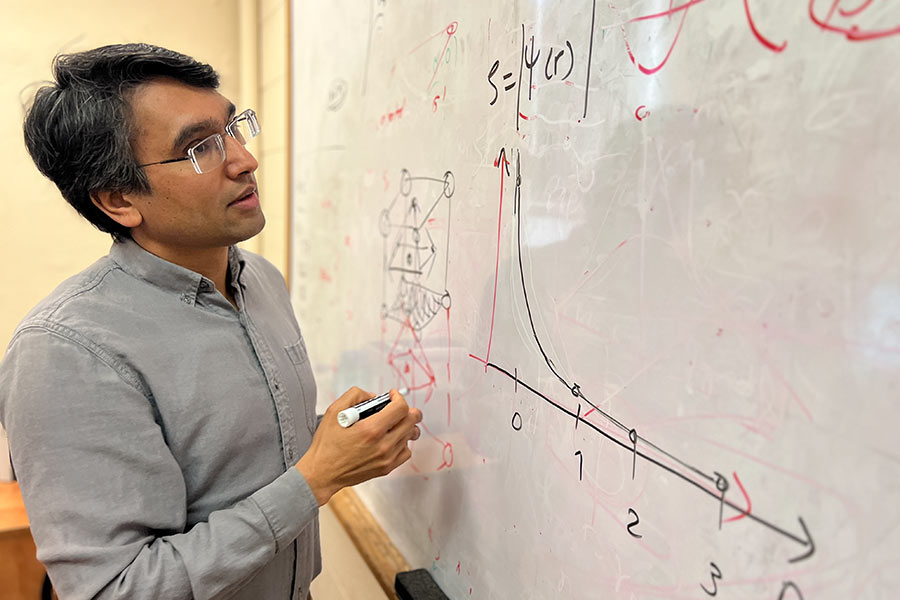Tula R. Paudel, Ph.D., assistant professor of
physics at South Dakota Mines is among the researchers who helped discover new active
materials for computer memory. The discovery could lead to increased memory
storage in a smaller space at increased computer speeds.
Paudel and the team are working with multiferroic materials
that can be electrically and magnetically polarized. Magnets inside a compass
are one example of material that can be magnetically polarized; one side of the
magnet will always point toward the magnetic north pole. In the 1920s,
researchers found that certain materials can change their polarization when an
electric current is applied. These materials are called ferroelectric. Both
electrical and magnetic polarization co-exists in multiferroic materials.
Ferroelectric materials like magnets contain
polarized regions called domains separated by thin walls. An electric field can
switch the polarization of these regions and, like a switch, record a direction
as one or a zero.
In recent years researchers have begun to study ferroelectricity
on smaller and smaller scales. This has led to a focus on the thin boundaries,
or domain walls, that separate domains. Paudel and his team found that when
they applied electric current to a very thin layer of a ferroelectric Bismuth
ferrite, they could move these walls.
 The team showed that unlike a RAM on a magnetic
disk, which needs continued zaps of electricity to keep polarized directional
memory intact, this ultra-thin layer of bismuth ferrite will hold its
polarization even after the power shuts off. Paudel says that at these small
scales, the presence of oxygen vacancy within the crystalline structure of the
material helped balance the charge in the domain walls, thus, locking them in
place until a current is again applied. The potential of this discovery is that
computers using this technology would have intact memory even when shut down
without allowing for storing memory in magnetic storage. Furthermore, the team
found they could store more memory than just using 1's and 0's with these
methods.
The team showed that unlike a RAM on a magnetic
disk, which needs continued zaps of electricity to keep polarized directional
memory intact, this ultra-thin layer of bismuth ferrite will hold its
polarization even after the power shuts off. Paudel says that at these small
scales, the presence of oxygen vacancy within the crystalline structure of the
material helped balance the charge in the domain walls, thus, locking them in
place until a current is again applied. The potential of this discovery is that
computers using this technology would have intact memory even when shut down
without allowing for storing memory in magnetic storage. Furthermore, the team
found they could store more memory than just using 1's and 0's with these
methods.
"This material allows us to expand from binary
memory to multiple memory. This could also allow a computer that could be
computing and storing memory at the same time," says Paudel.
Paudel says this property is called a memristive
behavior—or a type of device that memorizes the polarization state through it.
This discovery could have great value in the creation of next-generation computing
technology.
"We know how to create these domains; we know
how to control these domains. We understand the fundamental science behind the
process," he says. "There is a lot more work that needs to be done to
convert this fundamental knowledge to devices."
Paudel began work with this team during his tenure as
a post-doc at the University of Nebraska Lincoln. You can read
more about this research in this article. The scientific paper on this
subject, published in the journal Nature, is titled, In-plane
charged domain walls with memristive behavior in a ferroelectric film. Paudel is
continuing the research as a faculty member in the physics department at South
Dakota Mines. His separate work on ultrathin ferroelectric films Prominent Size Effects Without a
Depolarization Field Observed in Ultrathin Ferroelectric Oxide Membranes has recently been
published in the journal Physical Review Letters.
"This is a very collaborative effort, it's a
multi-national and multi-institutional effort. I am excited about the future of
this work," he says. He's currently working with three graduate students
on this research and other projects in this field. He is seeking more students
to work with.